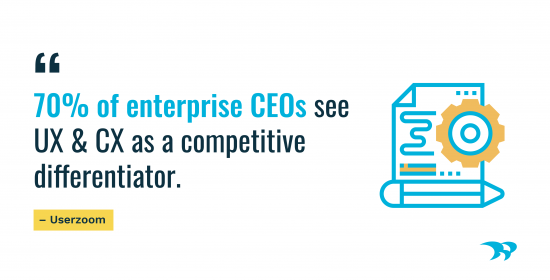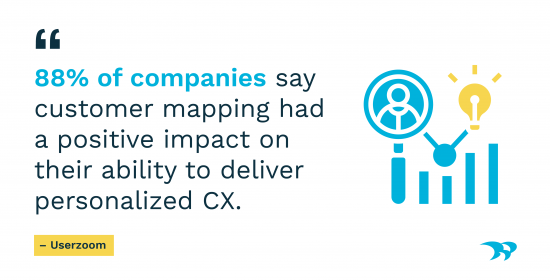Customer engagement in a world that’s more and more virtual, is requiring businesses to take a hard look at the user experience (UX) with their entire business. Is the user experience consistent throughout the customer journey and across platforms?
Unfortunately, when you talk UX, many people think you’re only talking about the colours or design of a website or custom application. In practice, UX is so much more.
Customer-Centric Focus
 One of the first things to realize is that a great UX doesn’t begin and end with application or website design. While design is a critical element, the user experience is so much broader and encompasses your customers’ engagement with your entire business. All the flashy bells, whistles and pretty designs won’t achieve a true customer-centric experience if other parts of the customer journey are lacking.
One of the first things to realize is that a great UX doesn’t begin and end with application or website design. While design is a critical element, the user experience is so much broader and encompasses your customers’ engagement with your entire business. All the flashy bells, whistles and pretty designs won’t achieve a true customer-centric experience if other parts of the customer journey are lacking.
How a customer is treated when they call support or customer service, the email or mobile offers they receive, response time to inquiries, reviews by other customers and media reports all contribute to the customer’s perspective of their “experience”.
A customer’s experience crosses individual touchpoints and so a positive UX can’t be created effectively in isolation. A customer-centric approach needs to cover the entire customer journey.
User Experience Tips
As you start thinking about UX, here are 7 tips to keep in mind beyond the look and feel of your customer-centric application or website.
- Discuss UX Sooner: Too often companies start working on their websites or applications and focus exclusively on business goals, features and functions. They don’t discuss user experience until they’re well down the development process. But if UX experts have an opportunity to weigh into the process from the beginning, they can suggest approaches or elements that will help enhance the experience. Earlier involvement of UX will improve the end product and you’ll avoid having to fix problems when you’re almost at the finish line.
- You are NOT the User or Customer: One of the biggest mistakes stakeholders make is assuming they are their target customer, or that they think and behave like their target customer, and they’re building a solution for someone like themselves. Your pre-conceived ideas of what a customer wants or needs aren’t always accurate and could mean you are developing a product that won’t succeed in delivering the customer centric UX you’re seeking. We’ve had clients who were ready to delete sections of their application because they didn’t think they were important. When we did a little research, we realized it was a highly visited and valued feature. Have an open mind and let your customers guide you to the solution they want. It’s all about their experience, not yours.
- Do Your Research: Before starting a project, collect user data and analyze the behaviour of people interacting with your site or application. User research, surveys and watching user interactions help you identify the problems people are having, as well as features that are important to them. Looking at the application from the user’s point of view will let you tailor your solution to them and their needs.

- Test Assumptions: In our industry, testing is often left as a final step before an application or website is rolled out. But incorporating testing at different stages in the development process can fine tune the approach and help us make sure we are addressing customer requirements at every step. We often take wireframe concepts and create prototypes so we can conduct mid-development user experience testing. This helps us verify that the approach we are taking resonates with the user and is truly aligned with the experience that the customer wants.
- Think Accessibility: 22% of Canadians (6.2 million people) over the age of 15 have at least one disability that limits everyday activities. For example, poor vision or poor mobility. Yet accessibility is often a forgotten element when thinking about user experience. Building a website or application with only fully able users in mind limits your reach. And in many regions, adhering to Web Content Accessibility Guidelines, Accessibility for Ontarians with Disabilities Act and Accessible Canada Act (Bill C-81) is required. Ensure your design and architecture doesn’t exclude a large audience group.
- Consider New Tech & Changing Behaviours: There are a lot of new technologies that companies should consider in the development of solutions. Business applications are increasingly leveraging voice assistants where access to keyboards or physical devices is challenging (like healthcare, manufacturing and industry). Artificial intelligence could be added to workflows to build efficiencies or augmented reality used in manufacturing, retail and safety systems. In addition to increasing efficiency, these technologies can help to improve the experience of the user by offering them greater control over how they interact with you and your services.
- Look to the Future: Every project should include a forward-looking wish list. Planning today for features or functions you’ll want to include tomorrow will ensure the architecture can scale to meet future requirements and will help you make sure these future features fit seamlessly and won’t impact UX down the road.

The Bottom Line: User experience is a competitive differentiator and a ongoing process
Building a customer or user centric business doesn’t happen in a vacuum. It takes a cultural shift across an organization to ensure synergy at all levels of customer or user interaction. User experience is still a new concept and it can be hard to shift thinking, especially in established businesses with well-rooted processes. It takes patience, persistence and the ability to unlearn and relearn to see your business through customers’ eyes.
And, while it might be challenging at the start, the effort is worthwhile. Companies and businesses that prioritize custom-centric ways of operating will be more profitable and successful over the long run. All of the most successful businesses today have embraced customer-centric, UX thinking.
Are you ready to build a website or custom application with UX at the heart of it? Let’s chat.